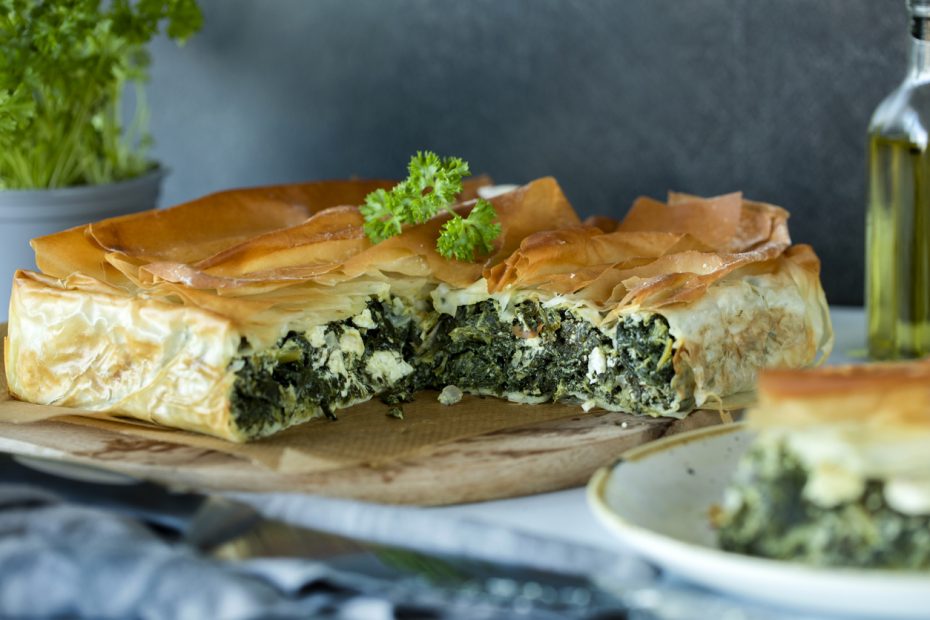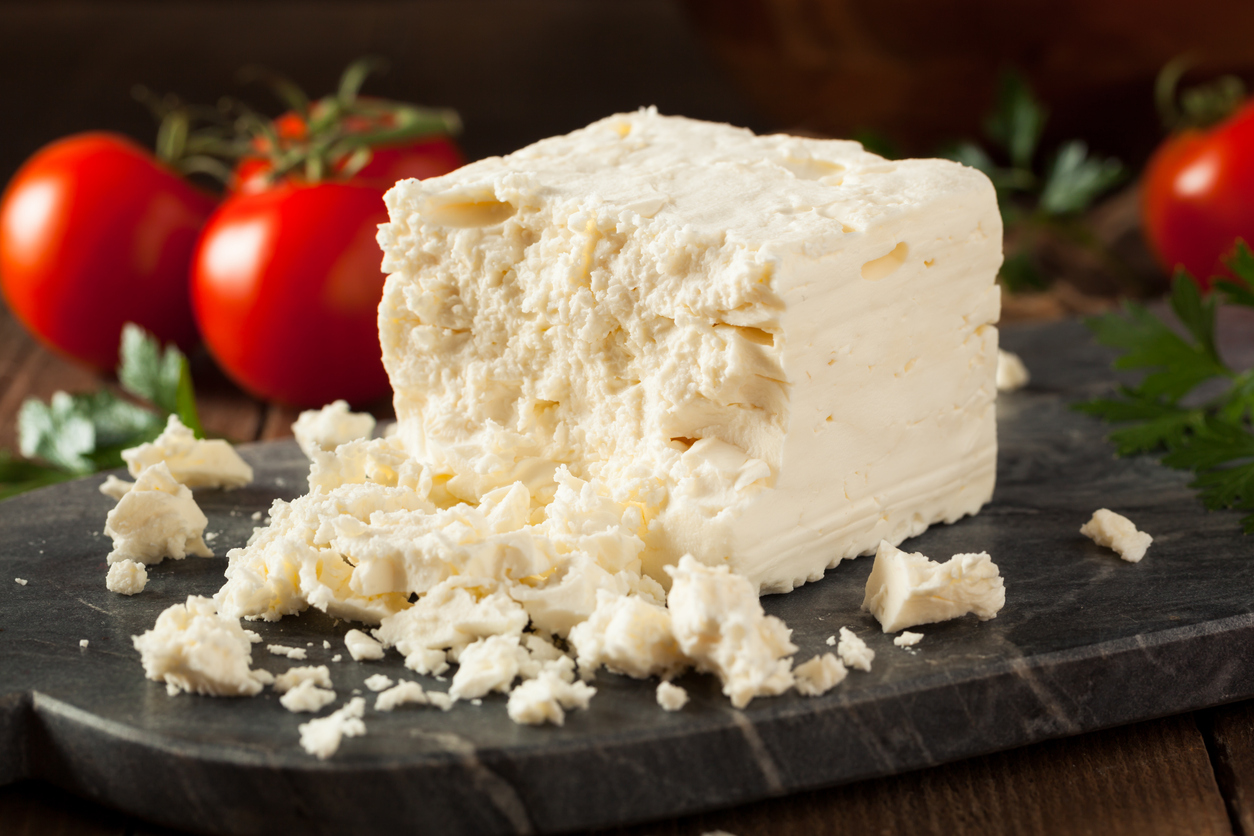What is Spanakopita
Spanakopita is a beloved Greek savory pastry that features a delicious filling of spinach, onions, leeks, dill, and, often, feta cheese (technically this would be called spanakotyropita in Greek), all wrapped in flaky layers of phyllo dough. This iconic Greek dish is a staple in Greek cuisine and has become a popular menu item around the world.
The key ingredients in traditional spanakopita include spinach, onions, leeks, dill, extra virgin Greek olive oil, and creamy feta cheese. The spinach filling is sautéed with the aromatic vegetables and seasoned to perfection before being layered between sheets of delicate phyllo pastry. The phyllo dough provides a crisp, golden-brown exterior that contrasts beautifully with the tender, flavorful filling.
Spanakopita can be prepared in a variety of ways, from individual triangular pastries to large baking dish-style pies. Regardless of the format, the combination of the spinach, feta, and flaky phyllo dough creates a harmonious balance of flavors and textures that makes spanakopita a truly exceptional Greek delicacy.
Spanakopita Ingredients: Fresh vs Frozen Spinach
When it comes to making the classic Greek dish spanakopita, the choice between fresh and frozen spinach can make a big difference in the final result. Both have their pros and cons, so it’s important to understand the differences when deciding which to use.
Fresh spinach offers a vibrant, verdant flavor and delicate texture that can elevate the overall taste of the spanakopita. However, working with fresh spinach requires more preparation time, as the leaves need to be thoroughly washed, dried, stemmed and chopped, the finally sauteed or steamed to release their moisture, before incorporating into the filling. Frozen spinach, on the other hand, is a convenient option that saves time on prep work. The downside is that frozen spinach can sometimes release more liquid during cooking, which can make the filling soggy if not properly drained.
Another factor to consider is the type of frozen spinach. Chopped frozen spinach is easier to work with, as the pieces are already broken down. Whole leaf frozen spinach may require additional chopping before adding to the filling. Whichever route you choose, be sure to thoroughly thaw and drain the frozen spinach to remove excess moisture.
Ultimately, both fresh and frozen spinach can work well in spanakopita, so the decision often comes down to personal preference and the time you have available for preparation. Experiment with each to see which you prefer for your homemade version of this beloved Greek pastry.
Fresh Spinach Tips for Making Spanakopita
If using fresh spinach, baby spinach leaves tend to work best. The smaller, tender leaves will wilt down more easily and incorporate seamlessly into the filling. Larger, mature spinach leaves may require more chopping and can result in a coarser texture.
Frozen Spinach Tips for Making Spanakopita
Frozen spinach can be a convenient option, but requires a bit more preparation. The key is to thoroughly defrost and drain the spinach before adding it to the filling. The best method is to place the frozen spinach in the refrigerator to thaw overnight. This slow, gradual defrosting helps retain the most flavor and texture. Alternatively, you can defrost in the microwave, but be careful not to overcook it.
Once defrosted, be sure to squeeze out as much excess moisture as possible. This will prevent the filling from becoming watery. The drier the spinach, the better it will bind with the other ingredients.
Ultimately, both fresh and frozen spinach can work well in spanakopita. Consider your time constraints and personal preference when deciding which option is best for your recipe.
Spanakopita Ingredients: The Alliums (Leeks, Onions, Scallions)
Leeks, onions, and scallions are all essential ingredients in the classic Greek dish, spanakopita. Each of these alliums brings a unique flavor profile that contributes to the overall taste of the spinach filling.
Leeks add a mild, sweet onion-like flavor, while onions provide a more pungent, savory note. Scallions, also known as green onions, offer a delicate, slightly grassy taste. Using a combination of these three ingredients creates a well-rounded, harmonious flavor in the spanakopita filling.
When preparing the filling, it’s generally recommended to use all three alliums together. This allows you to take advantage of their complementary flavors. Just be sure to thoroughly wash the leeks to remove any dirt or grit trapped between the layers.
After washing, the leeks, onions, and scallions should be sautéed for 5-7 minutes, until softened and fragrant, before being added to the spinach mixture. This gentle cooking helps to mellow the stronger flavors and allows them to meld seamlessly with the other filling components.
Which Onions Are Best for a Spanakopita Filling?
When preparing the filling for a traditional Greek spanakopita, the type of onions used can make a difference in the final flavor profile. While all onion varieties can be used, there are some distinctions to consider:
Red onions tend to have a more pronounced, pungent flavor that can stand up well to the strong tastes of the spinach and feta in spanakopita. Their color also provides a nice visual contrast.
Yellow onions are a classic choice, offering a balance of sweetness and savory notes that complements the other spanakopita ingredients nicely. They have a medium-strength onion flavor.
White onions are the mildest of the three main onion varieties. They will contribute onion flavor without overpowering the other components of the spanakopita filling. This can be desirable if you want a more subtle onion presence.
Ultimately, the type of onion used often comes down to personal preference. Many traditional spanakopita recipes call for yellow onions, but experimenting with red or white onions can also yield delicious results, depending on the flavor profile you’re aiming for.
Spanakopita Ingredients: Herbs
The most common fresh herbs used in traditional spanakopita (Greek spinach pie) are dill, parsley, and mint. These aromatic herbs complement the spinach and feta filling perfectly, adding brightness and freshness.
Dill is a key ingredient, providing a subtle licorice-like flavor. Parsley adds a clean, herbaceous note, while mint lends a refreshing coolness. These three herbs are considered the “holy trinity” when it comes to spanakopita fillings.
Other fresh herbs that can work well include chives, thyme, and oregano, though you’ll want to use these more sparingly as they have stronger flavors that could overpower the delicate spinach. Herbs like rosemary and sage are generally avoided, as their robust, piney notes don’t pair as nicely.
When prepping the herbs, make sure to finely chop them so they disperse evenly throughout the filling. Add the fresh herbs towards the end of cooking the spinach mixture, as you don’t want them to lose their vibrant flavor and aroma from prolonged heat exposure. A light hand is key – you want the herbs to complement, not dominate, the other flavors in your spanakopita.
Ingredients in Spanakopita: Feta
Feta can be an essential ingredient in spanakopita, one that gives it a signature flavor and texture. There are versions of spanakopita that don’t call for any cheese at all, and others that do, and these are generally referred to as spanakotyropita (spinach-cheese pie) in Greek.
If you do opt to use feta, choose authentic Greek feta, which is made from sheep’s milk or sheep’s and goat’s milk. Greek feta adds a tangy, salty punch that perfectly complements the spinach, onions, and herbs in the filling.
Unlike feta produced in the United States, which is often made from cow’s milk, true Greek feta has a distinct briny, slightly acidic taste and a crumbly, creamy consistency. This is due to the milk used, the traditional cheesemaking process that feta producers have to follow, since it’s a PDO (Protected Designation of Origin) cheese, and the terroir of the Greek regions where it originates.
Ration of Feta to Spinach Filling
When preparing spanakopita, it’s important to use the proper ratio of feta to the spinach-allium-herb mixture. A good rule of thumb is about 1 part feta to between 3 and 5 parts of the spinach filling, depending on how creamy or tangy you like it. This ensures the feta flavor shines through without overwhelming the other ingredients.
To incorporate the feta, gently crumble it with your fingers rather than chopping it. This preserves the texture and prevents the cheese from becoming too dense in the filling. With the right feta and the perfect filling balance, you’ll achieve the authentic, mouthwatering spanakopita of your dreams.
Eggs in Spanakopita Filling: Exploring the Differences
When it comes to the traditional Greek dish of spanakopita, the inclusion of eggs in the filling is a topic of debate. While American versions of this savory pie often incorporate eggs, the original recipes from Greece typically do not.
The role of eggs in the spanakopita filling can have a significant impact on the overall texture, flavor, and density of the final product. The protein in eggs helps to bind the filling, creating a richer, more custard-like consistency. This can be desirable for those seeking a heartier, more substantial spanakopita. However, the traditional Greek approach results in a lighter, more delicate filling that allows the flavors of the spinach and feta to shine.
For a 9×13 inch pan of spanakopita, most recipes recommend using 2-3 eggs per filling. This helps to achieve the desired balance of creaminess and airiness. When omitting the eggs, the filling may be slightly more prone to separation or leakage, but the pure flavors of the spinach and cheese can be more pronounced.
Ultimately, the choice of including eggs in spanakopita comes down to personal preference and the desired texture. Both versions can be delicious, allowing home cooks to explore the nuances of this beloved Greek dish.
Techniques for Incorporating Eggs into the Spanakopita Filling
Whisking the eggs helps to fully incorporate them and prevents any uneven distribution in the final filling. This ensures a smooth, cohesive texture throughout the spanakopita. Simply cracking the eggs directly into the spinach mixture and stirring may result in some areas having more egg than others.
For the best results, whisk the eggs thoroughly in a separate bowl before folding them into the sautéed spinach, onions, herbs, and other filling ingredients. This allows the eggs to disperse evenly and bind everything together seamlessly. Taking this extra step helps create the signature custard-like interior of traditional spanakopita.
Olive Oil: An Ingredient in Authentic Spanakopita
When it comes to making traditional Greek spanakopita, the type of olive oil you use is crucial. For the best results, it should always be extra virgin olive oil, preferably from Greece.
Extra virgin olive oil lends a rich, authentic flavor to the dish that cannot be replicated with other types of oils. During the sautéing process, the olive oil helps to gently cook the spinach, onions, and herbs, allowing their flavors to meld together seamlessly.
Later in the recipe, the olive oil is also incorporated into the filling mixture. This not only adds moisture and richness, but helps to bind all the ingredients together for a cohesive, flavorful spanakopita.
The grassy, peppery notes of Greek extra virgin olive oil complement the other classic spanakopita flavors perfectly. Be sure to use a high-quality olive oil to achieve the most delicious, true-to-tradition spanakopita.
In the next blog post on Spanakopita, I’ll be writing all about the phyllo pastry and will be looking at olive oil vs butter when lubricating the layers!
Check out my classic spanakopita recipe here:
Check out my classic spanakopita recipe on YouTube!
Did you know you can use the spanakopita filling in lots of different ways beyond “just” the phyllo pie?
Check out my FREE E-book, Spanakopita Everything, HERE!











